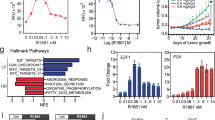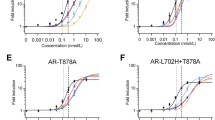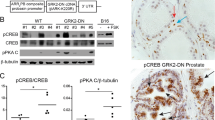Abstract
The androgen receptor (AR) is involved in the development, growth and progression of prostate cancer1 (CaP). CaP often progresses from an androgen-dependent to an androgen-independent tumor, making androgen ablation therapy ineffective. However, the mechanisms for the development of androgen-independent CaP are unclear. More than 80% of clinically androgen-independent prostate tumors show high levels of AR expression1. In some CaPs, AR levels are increased because of gene amplification2 and/or overexpression, whereas in others, the AR is mutated3,4,5. Nonetheless, the involvement of the AR in the transition of CaP to androgen-independent growth and the subsequent failure of endocrine therapy are not fully understood. Here we show that in CaP cells from a patient who failed androgen ablation therapy, a doubly mutated AR functioned as a high-affinity cortisol/cortisone receptor (ARccr). Cortisol, the main circulating glucocorticoid, and its metabolite, cortisone, both equally stimulate the growth of these CaP cells and increase the secretion of prostate-specific antigen in the absence of androgens. The physiological concentrations of free cortisol and total cortisone in men6,7 greatly exceed the binding affinity of the ARccr and would activate the receptor, promoting CaP cell proliferation. Our data demonstrate a previously unknown mechanism for the androgen-independent growth of advanced CaP. Understanding this mechanism and recognizing the presence of glucocorticoid-responsive AR mutants are important for the development of new forms of therapy for the treatment of this subset of CaP.
This is a preview of subscription content, access via your institution
Access options
Subscribe to this journal
Receive 12 print issues and online access
$209.00 per year
only $17.42 per issue
Buy this article
- Purchase on SpringerLink
- Instant access to full article PDF
Prices may be subject to local taxes which are calculated during checkout



Similar content being viewed by others
References
Trapman, J. & Brinkmann, A.O. The androgen receptor in prostate cancer. Path. Res. Pract. 192, 752– 760 (1996).
Visakorpi, T. et al. In vivo amplification of the androgen receptor gene and progression of human prostate cancer. Nature Genet. 9, 401–404 (1995).
Taplin M.E. et al. Mutation of the androgen-receptor gene in metastatic androgen-independent prostate cancer. N. Engl. J. Med. 332, 1393 –1398 (1995).
Gaddipati, J. et al. Frequent detection of codon 877 mutation in the androgen receptor gene in advanced prostate cancers. Cancer Res. 54, 2861–2866 (1994).
Gottlieb, B., Beitel, L.K., Lumbroso, R., Pinsky, L. & Trifiro, M. Update of the androgen receptor gene mutations database. Hum. Mutat. 14, 103–114 (1999).
Van Cauter, E., Leproult, R. & Kupfer, D.J. Effects of gender and age on the levels and circadian rhythmicity of plasma cortisol. J. Clin. Endocrinol. Metab. 81, 2468–2473 (1996)..
Walker, B.R., Best, R., Noon, J.P., Watt, G.C. & Webb, D.J. Seasonal variation in glucocorticoid activity in healthy men. J. Clin. Endocrinol. Metab. 82, 4015 –4019 (1997).
Zhao X.Y. et al. Two mutations identified in the androgen receptor of the new human prostate cancer cell line MDA PCa 2A. J. Urology 162, 2192–2199 (1999).
Navone, N.M. et al. Establishment of two human prostate cancer cell lines derived from a single bone metastasis. Clin. Cancer Res. 3, 2493–2499 (1997).
Horoszewicz, J.S, et al. LNCaP model of human prostatic carcinoma. Cancer Res. 43, 1809–1818 ( 1983).
Suzuki, H. et al. Androgen receptor gene mutations in human prostate cancer. J. Steroid Biochem. Mol. Biol. 46, 759– 765 (1993).
Watanabe, M. et al. Genetic alterations of androgen receptor gene in Japanese human prostate cancer. Jpn. J. Clin. Oncol. 27, 389–393 (1997).
Veldscholte, J. et al. A mutation in the ligand binding domain of the androgen receptor of human LNCaP cells affects steroid binding characteristics and response to anti-androgens. Biochem. Biophy. Res. Commun. 173 , 534–540 (1990).
Roux, S. et al. Mutation of isoleucine 747 by a threonine alters the ligand responsiveness of the human glucocorticoid receptor. Mol. Endocrinol. 10, 1214–1226 (1996).
Warriar, N., Page, N. & Govindan, M.V. Transcription activation of mouse mammary tumor virus-chloramphenicol acetyltransferase: a model to study the metabolism of cortisol. Biochemistry 33, 12837–12843 (1994).
Hollenberg, S.M. et al. Primary structure and expression of a functional human glucocorticoid receptor cDNA. Nature 318, 635– 641 (1985).
Cleutjens, C.B. et al. Both androgen receptor and glucocorticoid receptor are able to induce prostate-specific antigen expression, but differ in their growth-stimulating properties of LNCaP cells. Endocrinology 138, 5293–5300 (1997).
Stamey, T.A. et al. Prostate-specific antigen as a serum marker for adenocarcinoma of the prostate. New Engl. J. Med. 317, 909–916 (1987).
Lubahn, D. et al. Sequence of the intron/exon junctions of the coding region of the human androgen receptor gene and identification of a point mutation in a family with complete androgen insensitivity. Proc. Natl. Acad. Sci. USA 86, 9534–9538 ( 1989).
Oakley, R.H., Webster, J.C., Sar, M., Parker, C.R. Jr., & Cidlowski, J.A. Expression and subcellular distribution of the beta-isoform of the human glucocorticoid receptor. Endocrinology 138, 5028–5038 ( 1997).
Acknowledgements
We thank A. Hoffman and T. Stamey for critical reading of the manuscript. This work was supported by grants from the National Institutes of Health, the American Institute for Cancer Research and the US Army Medical Research Acquisition Activity (to D.F.).
Author information
Authors and Affiliations
Corresponding author
Rights and permissions
About this article
Cite this article
Zhao, XY., Malloy, P., Krishnan, A. et al. Glucocorticoids can promote androgen-independent growth of prostate cancer cells through a mutated androgen receptor. Nat Med 6, 703–706 (2000). https://doi.org/10.1038/76287
Received:
Accepted:
Issue Date:
DOI: https://doi.org/10.1038/76287



